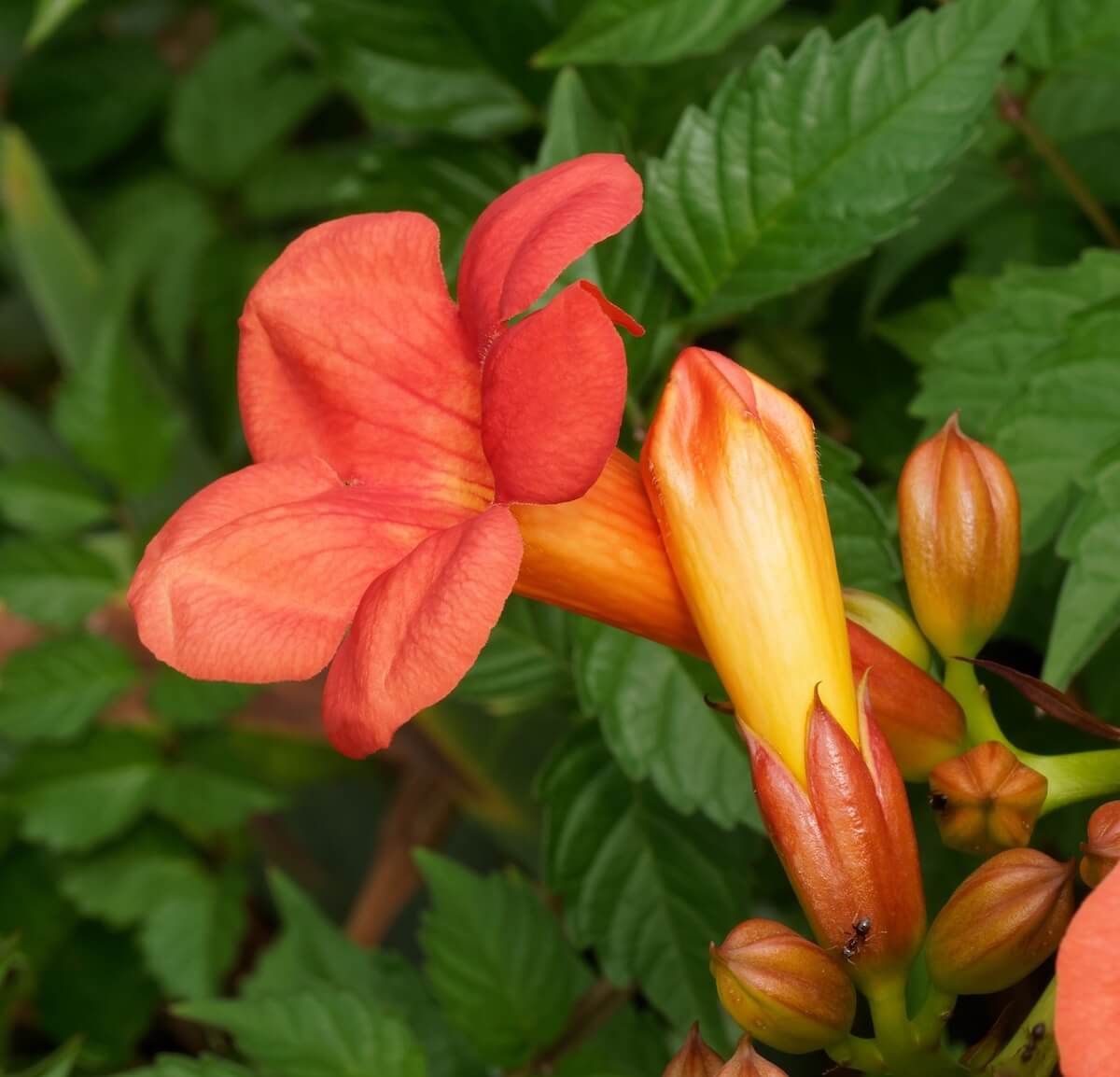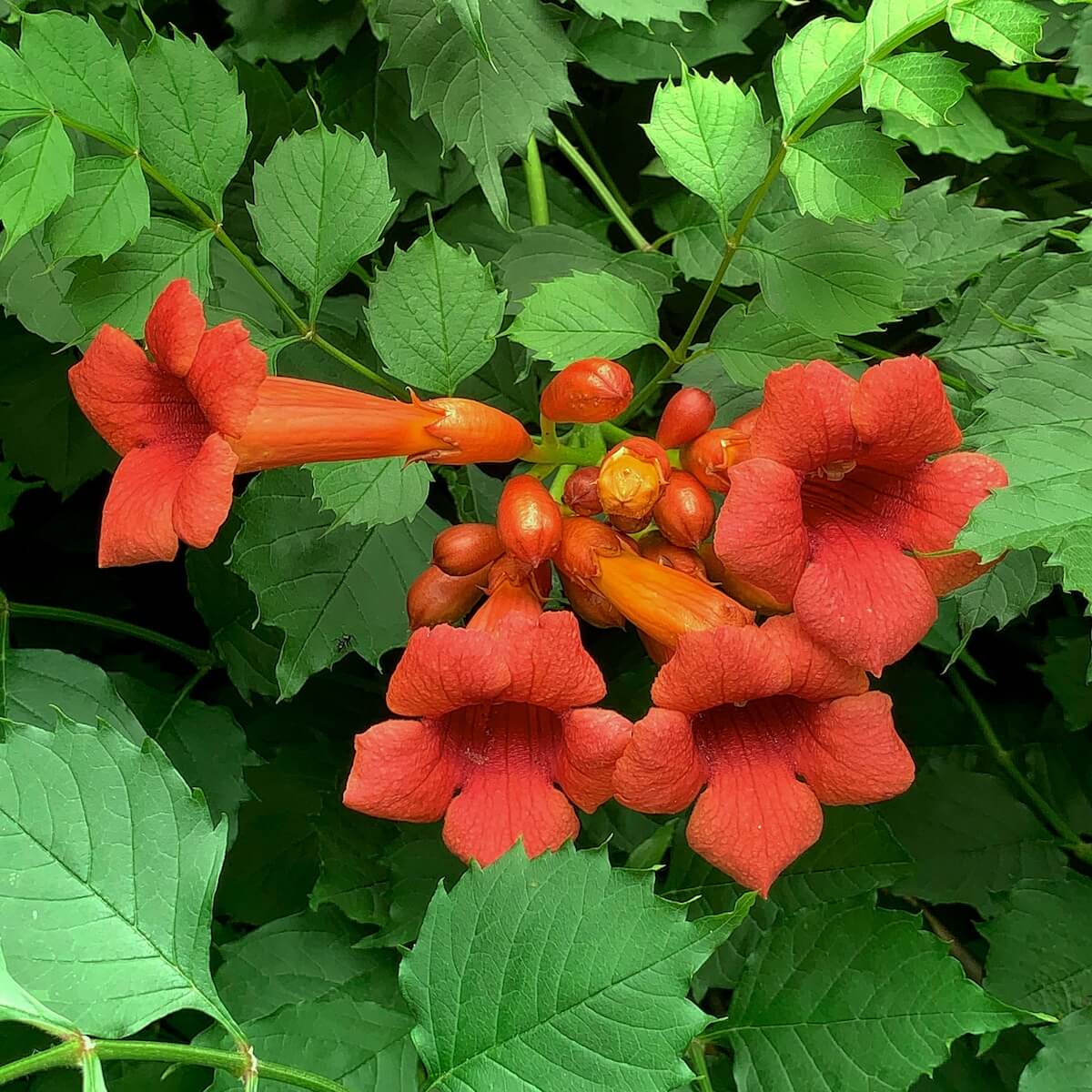
Position
- Prefers a position in full sun to ensure optimal growth and flowering
Hardiness
- Hardy down to approximately -20°C (-4°F)
Soil
- Thrives in well-drained, moderately fertile soil. Adaptable to sandy, loamy, and clay soils
- Tolerates a range of pH levels, including acid, neutral, and alkaline
- Grab a soil test kit and ensure the perfect conditions for growth
Height
- Can reach an approximate height of 6 to 10 metres (20 to 33 feet)
Seasons of Interest
- Flowering Times:
- Blooms from midsummer to early autumn, showcasing vibrant orange to red trumpet-shaped flowers
- Foliage:
- Offers deep green leaves throughout the growing season, without significant variegation or notable autumn colour changes
Discover the Bold Beauty of Campsis radicans: The Iconic Trumpet Vine
Welcome to the radiant and rewarding world of Campsis radicans, widely known as the trumpet vine. This fast-growing deciduous climber offers a captivating combination of architectural foliage, vibrant blooms, and ecological value. It is an exceptional choice for UK gardeners seeking dramatic impact with minimal effort. Whether revitalising a bare wall, adding character to a pergola, or creating a pollinator-friendly haven, Campsis radicans provides a showstopping solution that blends form, function, and flair.
What Is Campsis radicans? A Striking, Climbing Performer
Campsis radicans is a vigorous, woody climber native to the southeastern United States, but it has proven itself beautifully adaptable to temperate gardens across the UK. Celebrated for its trumpet-shaped flowers and lush foliage, this deciduous vine offers a bold and exotic appearance without needing tropical conditions. Its ability to scramble across walls, fences, and garden structures makes it ideal for creating height, privacy, and seasonal colour in small and large outdoor spaces.
Reaching impressive heights of 6 to 10 metres (20–33 feet), it’s the perfect candidate for vertical gardening, especially when introducing vibrant summer colour or supporting pollinator activity.
Show-Stopping Flowers and Tropical-Looking Foliage
One of Campsis radicans’ most striking features is its vibrant display of flowers. From mid-July through early autumn, clusters of large, trumpet-shaped blooms appear in dazzling shades of fiery orange, deep coral, or red. Each flower can reach up to 8 cm long, forming bold focal points that draw in bees, butterflies, and admiring glances alike.
The plant’s elegant foliage perfectly complements this impressive floral show. The pinnate leaves, composed of 7–11 leaflets, can grow up to 30 cm long, providing a lush, textural backdrop to the blooms. The contrast between the deep green leaves and bright blossoms adds depth and energy to any planting scheme, making Campsis radicans a visual and ecological asset.
Ideal Growing Conditions for Thriving Trumpet Vines
To get the best from Campsis radicans, choose a position that mimics its native habitat — warm, sunny, and sheltered. A south- or west-facing wall is ideal, where reflected heat can encourage a more profuse flowering display.
This adaptable climber tolerates various soil types, including sandy, loamy, and clay-based soils, provided they are free-draining. For optimal growth and health, plant in moderately fertile soil enriched with organic matter. While it prefers full sun, it can tolerate light shade, though flower production may be reduced.
Hardy down to -20°C (-4°F), this resilient vine is well suited to gardens throughout the UK, from urban courtyards to rural plots. Protection from strong winds will help safeguard its long stems and delicate flowers.
Planting and Establishing Campsis radicans for Long-Term Success
The best times to plant Campsis radicans are during spring or autumn, when soil temperatures are mild and moisture levels are favourable. Begin by digging a hole at least twice the width of the rootball and improving the soil with compost or well-rotted manure. Position the plant at the same depth it grew in its container, then backfill and water deeply to settle the roots.
Install a sturdy support system before or when planting — trellises, pergolas, fences, and masonry walls all work well. Guide the young shoots with soft garden ties as the plant grows until the aerial roots naturally take hold and secure the vine.
During its first year, water regularly to establish a strong root system. Once mature, Campsis radicans is relatively drought-tolerant but will reward consistent watering with more vigorous growth and generous flowering. An annual mulch of manure or bark chips helps retain soil moisture, suppress weeds, and improve soil fertility.

Pruning and Training for Shape and Performance
Though self-clinging, Campsis radicans benefit from early training to guide them into the desired shape. Use soft ties or clips to attach young stems to your support structure, encouraging even coverage and balanced growth.
Prune in late winter or early spring while the plant is still dormant. This annual pruning is crucial for encouraging abundant flowering and managing the plant’s vigorous habit. Cut back lateral shoots to two or three buds from the main framework. Remove dead, damaged, or overcrowded stems to improve airflow and reduce the risk of fungal diseases. With consistent pruning, you’ll enjoy a compact, floriferous display that performs beautifully year after year.
Managing Vigour: Keeping Your Trumpet Vine in Check
While Campsis radicans offers unmatched visual impact, its exuberant growth can become overzealous if left unchecked. This climber spreads readily and can produce suckers from the roots, particularly in warm or well-watered areas.
To maintain control, incorporate pruning into your regular garden maintenance. Remove any suckers or offshoots promptly, and consider installing underground root barriers if planting near borders or sensitive garden spaces. With thoughtful positioning and disciplined pruning, Campsis radicans can be a manageable and magnificent feature in your landscape.
Natural Resilience: Low Maintenance and Pest Resistance
One of the key advantages of growing Campsis radicans is its natural resilience. This hardy plant is rarely troubled by pests or diseases, making it an excellent choice for low-maintenance gardeners. Occasionally, aphids or scale insects may appear, but these are easily managed with horticultural soap or biological controls.
Proper airflow, achieved through regular pruning and strategic planting, helps prevent fungal issues like powdery mildew or leaf spot. Overall, this climber is a robust and reliable performer that brings high rewards for minimal effort.
Supporting Pollinators and Enhancing Garden Biodiversity
Beyond its ornamental value, Campsis radicans plays a valuable ecological role. Its nectar-rich flowers attract bees, butterflies, and hoverflies, contributing to local pollinator populations. The dense foliage offers shelter and potential nesting sites for insects and small birds, enriching the biodiversity of your garden.
By planting trumpet vine, you’re beautifying your outdoor space and creating a more sustainable and wildlife-friendly environment.
Garden Design Tips: Using Campsis radicans to Best Effect
Campsis radicans works well in various garden settings thanks to its tropical-style blooms and commanding presence. Use it to:
- Soften the hard lines of a brick wall or timber fence
- Add seasonal flair to an arbour or pergola
- Complement Mediterranean-style planting schemes
- Bring colour and life to wildlife gardens
- Create height and privacy in mixed borders
Pair it with silver-leaved perennials, ornamental grasses, or evergreen shrubs to contrast its warm flower tones and create dynamic planting combinations.
From Darren’s Patch
Campsis radicans has earned its place as a firm favourite in my garden, not just for its knockout blooms, but for its sheer energy in a space. Once established, it’s an absolute powerhouse: bold, brilliant, and buzzing with life. I’ve trained mine along a sunny brick wall, where it gets just enough heat to show off from midsummer onwards. The fiery flowers never fail to stop visitors in their tracks—and the pollinators love it just as much. It does need a firm hand with the secateurs in early spring, but that yearly tidy-up is well worth the pay-off. If you’re after drama, colour, and wildlife value all wrapped up in one reliable climber, this is the one I’d wholeheartedly recommend.
![]()
Key Points to Remember
- Botanical name: Campsis radicans (Trumpet Vine); a vigorous deciduous climber ideal for UK gardens.
- Stunning summer flowers: Produces bold, trumpet-shaped blooms in orange to red from midsummer to early autumn.
- Fast-growing: Reaches 6–10 metres (20–33 feet), perfect for covering walls, fences, pergolas, or trellises.
- Foliage: Deep green, pinnate leaves offer lush texture and contrast to the vibrant flowers.
- Sun-loving: Thrives best in full sun with shelter from strong winds; tolerates light shade.
- Soil requirements: Prefers well-drained, moderately fertile soil; adaptable to loam, sand, or clay.
- Hardy and robust: Tolerates temperatures down to -20°C (-4°F); suitable for most UK regions.
- Low maintenance: Drought-tolerant once established and generally pest- and disease-free.
- Essential pruning: Prune in late winter or early spring to encourage flowering and control growth.
- Vigorous habit: Can become invasive if unchecked; manage with regular pruning and sucker removal.
- Pollinator-friendly: Attracts bees, butterflies, and other beneficial insects, supporting garden biodiversity.
- Design flexibility: Perfect for Mediterranean-style gardens, wildlife-friendly borders, or vertical displays.
Few climbing plants offer the same dramatic effect, seasonal colour, and low-maintenance appeal as Campsis radicans. Whether creating a pollinator paradise, adding vertical interest, or simply looking to make a bold statement, this trumpet vine delivers on every level. Its vibrant flowers, architectural foliage, and hardy nature make it a superb investment for long-term garden beauty.
Add Campsis radicans to your planting palette and enjoy a garden that bursts with energy, texture, and year-after-year summer splendour.
Explore our full collection of planting guides for expert advice on climbers and wall shrubs.
Want to learn about other climbers and wall shrubs? Read about Campsis radicans Judy here.
Frequently Asked Questions
Q: How tall does Campsis radicans grow?
A: This vigorous climber reaches heights of 8-12 metres (26-40 feet) with proper support. The rapid growth rate makes it ideal for covering large walls, fences, or pergolas within a few growing seasons.
Q: What conditions does Trumpet Vine need to flower well?
A: Campsis radicans need full sun and warm conditions to produce their best flowering display. Plant it against a south-facing wall where it receives maximum sunlight and reflected heat.
Q: When does Campsis radicans flower?
A: The bright orange-red trumpet-shaped flowers appear from late summer through autumn, typically from July to September. Each cluster produces multiple blooms, creating a spectacular display that lasts several weeks.
Q: How hardy is Trumpet Vine?
A: This robust climber withstands temperatures below -15°C (5°F). It suits sheltered gardens in most UK regions but performs best in southern areas with warmer summers.
Q: What type of soil does it prefer?
A: Trumpet Vine adapts to most well-drained soils, including clay, loam, and sandy soils. It tolerates poor soil but grows most vigorously in fertile, moisture-retentive conditions.
Q: How should I prune Campsis radicans?
A: Prune hard in early spring before new growth starts. Remove overcrowded stems and cut back side shoots to 2-3 buds from the main framework to encourage strong flowering.
Q: Does it need special support?
A: Install strong wire systems or sturdy trellis work before planting. While it produces aerial roots for climbing, additional support helps manage its weight when mature.
Q: Is it suitable for container growing?
A: Yes, but use large, deep containers with good drainage. Regular watering and feeding become essential for container-grown plants, especially during the growing season.
Q: What wildlife does it attract?
A: The tubular flowers attract pollinating insects, particularly bees and butterflies. Birds often nest within its dense foliage during the summer months.
Q: Are there any potential problems to watch for?
A: The vigorous growth needs regular management to prevent it from overwhelming nearby plants. Suckers may appear from the roots, so remove these promptly if they’re unwanted
